Preview Special: JVC DLA-HD1 D-ILA projector
15000:1 native contrast with full HD resolution...
New reference for LCOS Home Cinema Projectors?
Cine4Home has already taken a closer look at the projector...

The LCOS technology has increasingly aroused some attention within the home
cinema world over the last coupe of years: it made the first Full-HD (1920x1080)
projectors possible and also with regard to contrast, LCOS has not only caught
up with the closest competitor in this domain, the DLP technology, but at the
latest since the Sony VPL-VW100 has given it a run for its money. In addition
there are the absence of annoying digital artifacts as well as an uncommonly
analog appealing "Film look". Thus LCOS projectors have established themselves in the last months to be a favorite of High-End home cinema friends.
Now the technology goes into the next round with one of the founding fathers of the LCOS technology: JVC. As early as 1998, JVC revealed the first LCOS projector with the phenomenal resolution (at that time) of 1360 x1024 pixels under the name "D-ILA". The JVC variant now appears again and stands up against the competitive Sony variant "SXRD" : the new DLA-HD1 combines a phenomenal native (!!) contrast of up to 15000:1 with the Full-HD resolution of 1920 x 1080 pixels, no other home cinema projector even comes close.
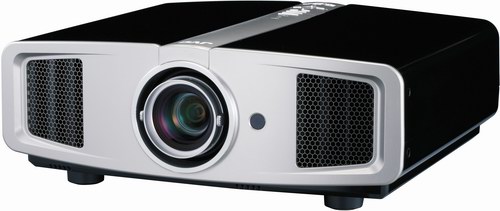
JVC HD-1, the new reference in home cinema?
JVC invited us to a first presentation of the new wonder beamer in their own location on Wednesday, December 13th 2006, an invitation we gladly accepted. It is not a secret that Cine4Home has had an eye on the promising D-ILA technology for a long time, and it was a personal highlight for us to be allowed to see and evaluate the results of the newest generation. In this Special we present you with a first overview of the most interesting innovations and above all their (hopefully) positive influences on the image quality:
Table of contents:
1. Native contrast of 15000:1, how is that possible? Background on the D-ILA technology
1.1 LCD, DLP and D-ILA (LCOS)
1.1.1 LCD
1.1.2 DLP
1.1.3 LCOS (D-ILA)
1.2 Structure of an LCOS projector
1.2.1 The optical path
1.2.2 Structure of an LCOS chip
1.2.3 Functioning of the LCOS chip
1.3 Optical path in practice
1.3.1 Splitting
1.3.2 "Polarization Beam Splitter"
1.3.3 The heart of LCOS with light output
1.4 Contrast-increasing measures in the new HD-1
1.4.1 New D-ILA panel with better polarization
1.4.2 Goodbye PBS, replaced by a new "Wire Grid"
2. High-quality scaling by Gennum VXP
3. Great placement flexibility because of Lens Shift and double Zoom Range
3.1 Zoom Range
3.2 Lens Shift
4. Other aspects
4.1 Design and processing
4.2 Ventilation and lamp
4.3 Inputs and signal variants
4.4 Operation
4.5 Menu
5. Our first picture impressions, what does the projector offer in practice?
7. Technical data (manufacturer data!)
1. Native contrast of 15000:1, how is that possible? Background on the D-ILA technology
In the past, the maximum achievable native contrast with digital home cinema projectors was "only" approx. 6000:1, and not rarely only using various iris technologies, which do give the picture more contrast, but also take away brightness from it. Lately also projectors with contrast data of over 10000:1 increasingly emerge, but these high On/Off contrast ratios are only achieved with help of so-called adaptive iris-es, which adapt the light-output to the brightness of the picture content.
How is it possible that a projector like the HD-A1 achieves a native contrast of 15000:1, completely without "cheats"?
This is a multiplication of past results. In order to answer this question, we first describe the fundamental functioning principles of the D-ILA technology, compared to LCD and DLP:
Everyone has a rough conception of how LCD projectors function: small LCD panels are lit like slides. For every basic color one of these electronic slides is available, on the screen the finished picture is displayed.
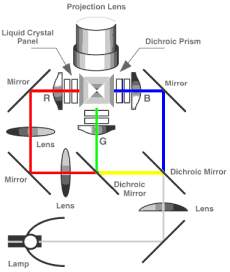
With DLP technology, no displays lit. A DLP chip consists of many small mirrors (pixels), which can be tilted away electronically. Thus the video picture of the chip is reflected instead of lit.

Affordable projectors use only one DMD chip and produce the colors sequentially, i.e. successively.
So how does the LCOS technology function? Roughly, this technology is a mixture of both LCD and DLP technology: as is the case for the LCD technology, small liquid crystals ensure the imaging here, but they are not lit but the light is reflected in a similar way as with DLP technology.
This special chip technology is called "Liquid Crystal On Silicone" or briefly "LCOS". In the following part we explain the structure of an LCOS projector in more detail:
1.2 Structure of an LCOS projector
In a LCOS projector, parallel to the LCD technology, three chips are operational: each basic color has its own LCOS chip available. In the optical path towards the screen, the picture is first divided by half permeable special glasses into its three basic colors, then "treated" by the LCOS chips and in the end joined again into a single picture by a prism.
As already described, the main difference lies in the reflective function. Because liquid crystals are used instead of mirrors, the functioning principles are slightly different.
1.2.2 Structure of an LCOS chip
The rough structure of an LCOS chip consists of three layers. The highest layer consists of glass, which is equipped with a transparent electrode.
The middle layer contains the liquid crystals with a vertically aligned arrangement (approx. 3 micrometers thick).
The bottom layer is again an electrode layer (separated into each pixel for control), this time however not transparent, but reflective (reflection approx. 91%), like a mirror. The advantage of this structure is that the entire control (address -) conductive strips are behind the mirror, which means that they are not in the optical path as is the case with the LCD technology. Between them is a special isolation layer, which prevents heat and light to influence the address lines.
Photo of an LCOS chip
By using this structure, individual pixels can be substantially closer to each other than with the LCD technology, where the address conductive strips are lit together with the LCD panel. Result of this is a rise in fill-rate. The first D-ILA projectors already had a pixel size of only about 13.5 µm², the distance between them being only 0.5 µm.
LCOS dimensions as used in the models G10/G11/G15 for example
Under the microscope, the tiny mirrors and the small distances between them can be seen quite well:
Photo of an LCOS "mirror"
1.2.3 Functioning of the LCOS chip
In front of each LCOS chip is a so-called "Polarization Beam Splitter", briefly PBS. It must be regarded as a special kind of mirror, which steers polarized (S-Polarization) light in certain way on the chip.
This incoming polarized light is now "treated" by the LCOS device in each pixel: an "inactive" pixel passes the polarized light unchanged, it is reflected by the mirror layer and leaves the same way as it came, on to the PBS light distributor. This again reflects the untreated light back into the projection lamp, no light is displayed on the screen:
Inactive: "black"
With an active pixel its a different story: here, the detailed S-Polarized light is "turned" into the so-called P-Polarization by the LCOS chip. After the reflection of the mirror layer the differently polarized light arrives once again into the PBS light distributor, where it is now not guided back into the lamp however, but finds its way into the optical path up to the screen.
Actively: "bright"
Between these two "maximum positions" there are an almost infinite amount of intermediate positions, which are determined by the Voltage between the electrodes. Depending upon position, more or less light arrives at the polarization divisors, which is how the difference in brightness is created.
If one takes a closer look at this structure, one will see that the light must pass the liquid crystal layer twice: once before the reflection by the mirror layer and once after. This makes a faster response time of the display possible, since they can "treat" the light twice. The response time between Maximum Brightness -> Black -> Maximum Brightness amounts to 5ms and less (depending upon model) with D-ILA projectors. Thus disturbing "trailing" effects are omitted even with higher frequencies.
Let's take a look again at the optical structure of an LCOS of projector (simplified):
The light, which is radiated by the lamp (Xenon and/or NSH), arrives at half permeable mirrors after passing several optics, which split the light up into blue and yellow (green + red). The blue light arrives in the optical "Polarization Beam Splitter" (PBS) for blue. The yellow light is divided into the two further basic colors red and/or green by a further half permeable mirror, and every basic color is then passed on to its own LCOS panel.
Optical path in the projector
In one of the first models, the G10, this looks like this:
The light of the lamp (the chamber left in the picture above), arrives at the optical block after passing various intregrator lenses over a mirror (above right). There it is divided into blue and yellow by a half permeable mirror (right).
1.3.2 "Polarization Beam Splitter"
The so-called "Polarization Beam Splitter" looks like glass cubes. In it, the special polarization dependent mirror is placed.
A "PBS"
Every one of the three LCOS panels has its own PBS in front of it. as described earlier it firmly belongs to the function principles of the technology, and accordingly has large influence on the quality of the projection. The better the high-quality polarization reflection characteristics of the PBS, the higher the attainable contrast ratio.
All three polarization splitters of a D-ILA projector
Directly behind the PBS the actual LCOS units are placed, which as above described affect the light in its polarization and thus determine whether the light arrives back into the lamp or on the screen.
In the light section they have their firm place right beside the appropriate PBS blocks:
The PBS integrated into the projector
1.3.3 The heart of LCOS with light output
LCOS chip are available in various resolutions and sizes. Currently, 1400 x 1050 pixel models and 1920x1080 pixel models (Full-HD) are used for private applications, as with the DLA-HD1.

LCOS devices in an overview
Below: the new variant of the HD1
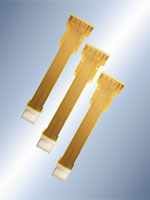
1.4 Contrast increasing measures in the new HD-1
So far the overview of the function principles of the D-ILA technology. If one paid attention to the remarks above, it is clear that the contrast depends primarily on two factors: the exact Polarization of the light by the LCOS panel and the reflection properties of the Polarization Beam Splitter. Up to now, the two weakest points of the technology showed: the crystal layer of the LCOS panels did not polarize the light absolutely perfectly due to an unevenness in the panel and the PBS, despite S-Polarization, always let through a certain portion of the light, instead of reflecting it completely. The HD-1 was fundamentally revised on both points:
1.4.1 New D-ILA panel for better polarization
For optimal control of the light polarization, an exact adjustment of the liquid crystals in the panel is important. These are located in a layer directly above reflecting electrodes. Lets take a closer look at the mirror surface again:
Photo of an LCOS "mirror"

As can easily be seen, the mirror surface is slightly uneven and each pixel is separated from the other one by a microscopically small gap. In the liquid crystal layer, these minimal dips result in "craters" where the crystals cannot be optimally aligned:

As the drawing above explains, the diagonal crystals in the gaps (encircled) cause a wrong polarization which has a negative effect on black level. The solution of this problem is as simple as it is ingenious: by using a special bonding material, the gaps between the pixels are filled up thus evened out. No craters remain and all crystals are aligned in parallel:
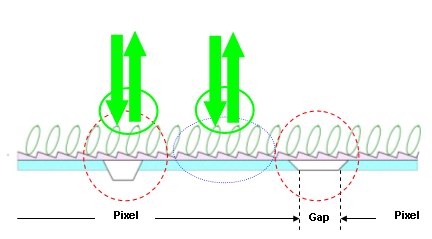
Even crystal layer with the new D-ILA panel
Because the crystal layer is more even, the polarization is more precise and "anomalies" are reduced. This way, contrast and Black Level are improved. In addition, a new crystal layer was used which reduces contrast reductions induced by diagional light angles (unavoidable in the optical system ):
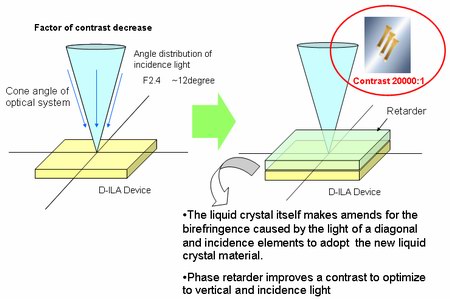
These two measures ensure that the new D-ILA panel reaches a contrast ratio of no less than 20000:1. But panel contrast alone is not enough, the remaining optical path must bring the high contrast ratio on to the screen. This brings us to the second weak point of LCOS projection:
1.4.2 Goodbye PBS, replaced by a new "Wire Grid"
No matter how well the LCOS panels polarize, as long as the pole mirrors let some light through, the full contrast cannot be achieved. Lets take a look again at the conventional LCOS optical path:
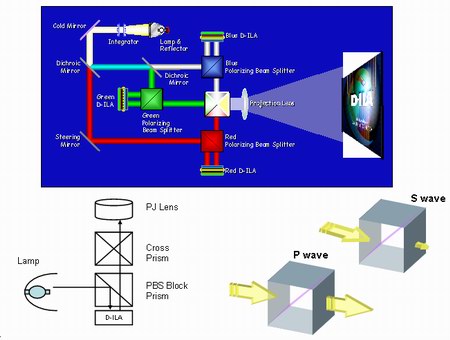
Each D-ILA panel is preceded by a PBS prism, which works as "light switch". P-polarized light is left through, S-polarized light is reflected. But a small quantity of light passes the PBS nevertheless (sketch above), so that the contrast is impaired. JVC has come up with something completely new here. Instead of trying to change the PBS, they completely replaced them with so-called "Wire Grids". These "Wire Grids" look like conventional halfpermeable mirrors to the naked eye, but the microscopic photo shows how they got their name:

Functioning principle of the "Wire Grids"
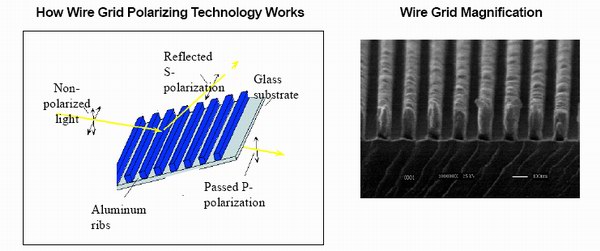
The microscopically small lamellas are able to separate polarized light more precisely than the PBS could. So the high native contrast of the LCOS panels can actually also be used in the optical path.
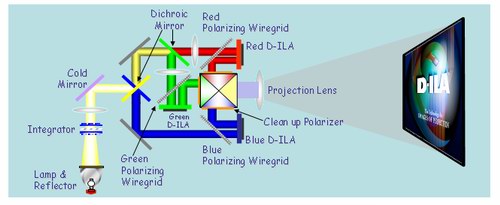
In the new optical path, a Wire Grid precedes each LCOS panel
New LCOS coating of the electrodes, new liquid crystal layer, new light switches before the LCOS panels. By using the combination of these three innovations the HD-1 succeeds in actually reaching a contrast ratio of 15000:1. So far, no other technology is able to minimize stray light in such a way like the variant presented above. The pleasant side effect: since no light-swallowing scattered light irises are used, a maximum brightness of up to 700 lumens remains, which let the projector appear as everything but dark. But with the DLA-HD1, they have not only paid attention to the contrast improvement, in many other areas the technical data are more than promising:
2. High-quality scaling by Gennum VXP
Finally the manufacturers understand that high-quality scaling in the projector becomes ever more important. The Mitsubishi HC5000 preceded here with the silicone Optix Reon chip set, which set a good example. And also JVC has started using high-end signal processing: in the DLA-HD1 a GF9351 video processor from the house Gennum is used. Aside from high-quality scaling, this offers four VXP features which otherwise can only be found in high-end scalers:

FineEdge™
Edge correction technology that gets rid of the jaggy artifacts so common to diagonal lines, creating instead smooth outlines.
FidelityEngine™
Imaging technology that improves detail while reducing noise. This technology ensures a clear, detailed playback picture even for video sources with lower resolutions.
TruMotionHD™
De-interlacing technology that supports HD signals (1080i), converting them to high-quality 1080p signals for playback.
RealityExpansion™
10-bit image processing technology. This technology can upsample 4:2:2 (Y:Cb:Cr) video signals to 4:4:4 format, and delivers outstanding image processing at a level comparable to that of broadcast masters.
3. Great placement flexibility because of Lens Shift and double Zoom Range
A modern projector must be flexible, since the differences in room integration often require special placement positions. Some rooms require a short distance, other rooms require a large one, while yet another room may require projector placement at the edge, away from the optical axis. Here we were more than positively surprised by the new characteristics of the HD1:
Projection Distance chart JVC DLA-HD1
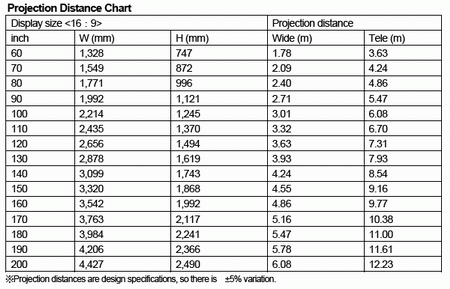
As one can see from the Projection Distance chart above, the projector offers a phenomenal Zoom Range. The for home cinema usual display width of e.g. 2,7 meters can already be realized from a distance of 3,6m(!!). In addition, in larger rooms, a distance of 7.3 meters is possible with the same dimension of picture area. Any more flexible the Zoom Range of a projector does not have to be.
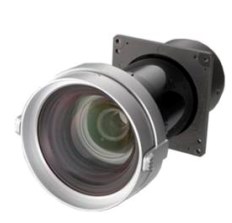
The optics of the DLA-HD1
And also Lens Shift has been thought about. This is equally large and clearly blows the competitor VPL-VW50 out of the water.
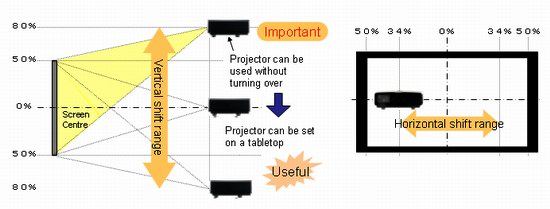
The projector can shift up to 80% in height and 34% in width from the axis. Especially the horizontal Shift range is so great it can not be found with any other Full-HD projector. Combined with the large Zoom Range, JVC clearly sets completely new standards here. The DLA-HD1 can be deployed without a problem in almost any room!
4.1 Design and build quality
During the presentation also the remaining characteristics of the new D-ILA of
projector became clear. Design and build quality stood out in a positive way.
The projector appears uncommonly elegant with its high polish finish, especially
considering its price range.
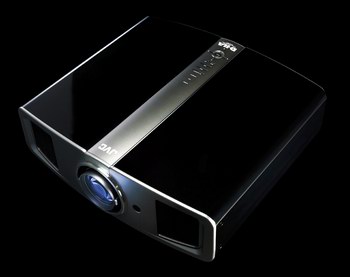
The combination of black and silver is a very successful one, and optically integrates elegantly in the room. Only in bright rooms some will be annoyed by the darkness of the housing. So far, the HD1 is only announced in black for Europe, yet we want to express our desire here to also offer the white variant as an option in Europe as well, which in Japan will already appear in January.

Also very elegant in white : The DLA-HD1W
Simply give us your opinion at info@cine4home.de: which color would you prefer? Apart from this question of taste, the projector raises above every suspicion. On the outside it embodies everything the manufacturer promises in the picture.
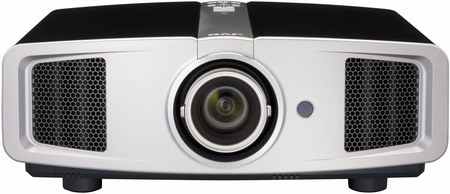
Front of the DLA-HD1..,
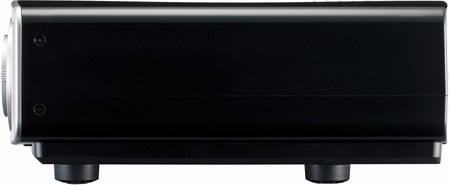
From the side...
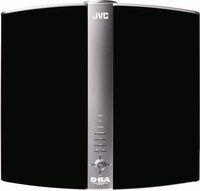
and from above.
Practical aspects were not neglected with the optical design. It is very praiseworthy for instance that the entire ventilation was shifted to the front of the machine. Here the projector sucks in the necessary cooling air at the right of the optics and blows out warmed up air left from the optics.
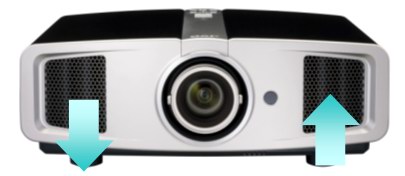
Ventilation system at the front of the projector
This system allows placement of the projector close to rear walls or even in a shelf. Placement flexibility is extended again in practice, it can not get any better. The ventilation is pleasantly quiet and does not disturb during movie viewing.
Also the lamp pit can be accessed comfortably from the side, so that in case of a lamp change the projector does not have to be loosened from its ceiling mount.

The lamp can be changed from the side
4.3 Inputs and signal variants
With the inputs one concentrates primarily on digital signal transmission. The projector offers two to HDMI (1.2) inputs, so that several devices can be digitally connected at the same time.
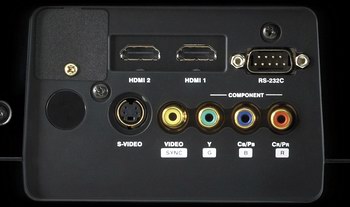
Beside the digital inputs the usual analog variants are present: component (YUV), S-Video and Composite. A point of criticism here is that only one of each input is present. Also, the projector has no separate VGA (RGB) - input, so that for the connection of a PC the Component input must be used, which processes RGB signals exclusively. Here the manufacturer could have been a little more "generous". Furthermore an RS232 interface is available for computer control.
The flexible signal support is pleasing: 480i/p, 576i/p, 720p60/50, 1080i60/50, 1080p60/50/24 the projector can process. Even the 1080p/24 processing (over HDMI) will more than please "Pull-down haters" in these times of HD-DVD and Blu ray.
Past D-ILA projectors tested by us did not exactly shine regarding their remote controls. They were more fitting to entry-level projectors rather than High-End devices. JVC obviously saw this, and gave the HD-1 a particularly beautiful infrared remote control.


The remote control is clearly structured and offers meaningful key allocations. Different presets as well as all inputs are directly selectable by pressing a key. At the same time the cross control is generously arranged. If necessary all keys can be lit electrically, so that readability is ensured also in dark rooms.
The menus are clearly arranged and offer numerous technical details. We can make no statement on the exact options however, since they were not all presented in the context of the presentation.

The (Japanese) menus of the Full-HD D-ILA projector
5. Our first picture impressions, what does the projector offer in practice?
So far all of this sounds like the "perfect projector": very good build quality, flexible placement, high-quality signal processing and finally a phenomenal native contrast of 15000:1. But can this be realized in practice also? Does the image quality live up to the promise of the technical data?
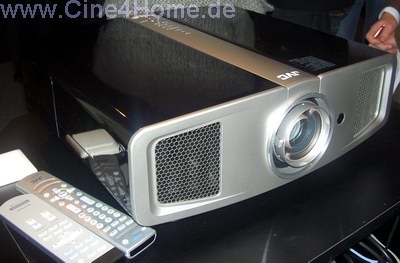
During the presentation engineers of JVC did not have anything to hide, on the contrary: in a direct comparison with the main competitor VPL-VW50 the strengths of the new projector should be illustrated. To do just that, both devices were displayed next to each other under optimal conditions in a black room:

The two "projector giants" in a direct comparison
In this setup the conditions were extremely fair: both projectors threw their images on screens of equal size and were fed the same signal.

Both projectors were in their factory settings: in the case of the Sony this was the Cinema mode with color temperature "Low", adaptive iris "Auto1" and lamp mode "Bright". In the case of the JVC we had to believe that the technical settings of the presented machine corresponds to the factory settings standard machines will have on delivery.
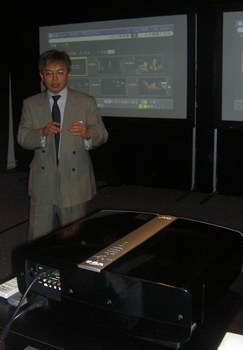
The setup was explained technically precise,
nothing was left unclear
The lights were turned off, the projectors on and we were more than surprised.
As a large advantage over the VW50, the native contrast of 15000:1 of the HD1
was given. Both models actually have the same contrast on paper, but in practice
they reach these in different ways: where the DLA-HD1 natively reaches this high
value by numerous improvements in the optical path (see chapter 1), the Sony
variant uses an Adaptive Iris, the opening degree of which always adapts to the
picture content in real time. The mechanics of the Sony succeed in doing this
extremely well. In our detailed test we explained the fact that the tandem of Adaptive Iris and Gamma Adjustment are imperceptible to the eye and outweigh the advantages: dark scenes offer a good Black Level and good coloration, bright scenes appear luminously radiating.
Nevertheless, the native contrast of the JVC projector does bring advantages. "why is that?" some readers will ask themselves, "on/off contrast is on/off contrast". This is correct in theory, but not completely in practice however. The following diagram is intended to clarify the difference:
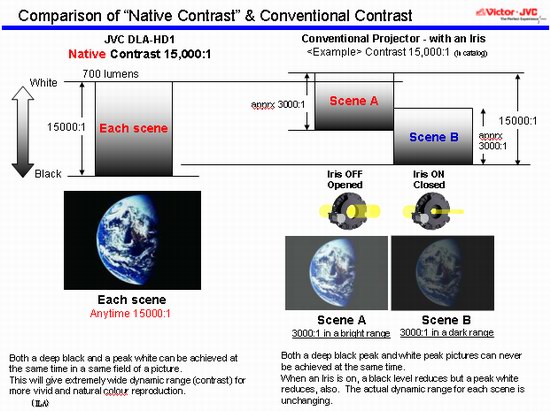
Left is the contrast ratio of the JVC represented schematically, it always amounts to 15000:1. That is, the Black Level is always equal darkly, the White Level always equivalent bright. On the right, the adaptive function of an iris is described. It closes with dark scenes and improves the Black Level. In bright scenes it opens and improves the maximum brightness. What always remains unchanged however is the native contrast of the projector, which in the case of the VW50 lies between 2000:1 and 4000:1 (depending upon opening degree). In other words: in one and the same picture, white can be at most 3000 times brighter as black. With the DLA-HD1, white can be 15000 times brighter however than black. So either bright details are brighter in an predominantly dark scene, or the Black Level is better.
This theory is more than plausible, but must be viewed sceptically in this form however. Because it ignores the various scattered light factors, which inevitably reduce the in picture contrast. Even with a native contrast of 15000:1 a projector will not be able to hold a contrast of 15000:1 in most scenes within a single image. The ANSI Contrast measurement is a good example here: with a projected chessboard the contrast between white and black fields never corresponds to the on/off contrast, but is always only a fraction, mostly between 250:1 and 600:1. Although the ANSI contrast of the DLA-HD1 should be impressively high, an exact number could not be given at the time of this preview however. The more important it was for us to observe the advantage of the native contrast on the screen with own eyes.
And this impression convinced us: the advantages of the native contrast in a direct comparison were actually very clear. Especially in dark scenes the picture depth visibly profited. While Black Level was on a slightly better level than the VPL-VW50, at the same time bright details were substantially more radiating. This was clearly visible for example with a starlit sky from Star Wars, the stars were clearly substantially more radiating than with the SXRD projector, the contrast between black space and bright stars was much more apparent. The following spaceship appeared also clearly more radiating, the picture increasingly gained in picture depth. This observation could be transferred to many scenes. Even in brighter TV scenes the in part more deep appearance of details was noticeable, owing to higher in image contrast.


The comparison above approximates the impression at the preview:
with the HD1 (right), better contrast was apparent especially in dark scenes
In addition, it must be said that the projected picture of the VPL-VW50 was still uncommonly deep. The Sony projector at present belonges to the reference standard in home cinema, and offers everything but a dull picture. Many are already swept away by the picture depth of the Sony beamer. Nevertheless, the JVC DLA-HD1 still succeeds in improving the VW50. The projector's picture is even more deep, contrast is even better. This shows the high level we at here. It was particularly surprising for us that the HD1 was brighter in the lamp mode Low, as the VW50 was in lamp Hi mode. At the same time, the JVC also managed to offer a better Black Level! No question, regarding contrast the new JVC projector sets a new milestone, not only compared to its direct competitor, but compared to all at present common technologies within the home cinema range. In addition, it must be said that the differences are not like night and day, it is however a visible step up from "Good+" to "Very Good".
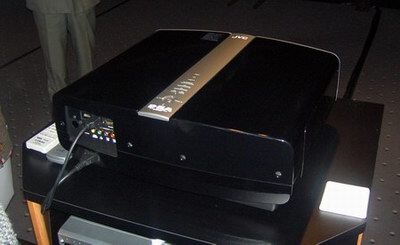
Not only a black miracle on the outside
After this direct comparison, the DLA-HD1 presented its picture alone on a large cinema screen of 3,5m wide. Various high-quality HD-material signals were fed.

Demonstration in the impressing cinema room on a large screen

Here the projector continued to impress with its outstanding signal processing,
which always ensured a very sharp picture. What was surprising was that the
light output was more than sufficient for such a large display width, the
picture always appeared brightly radiating.
We also looked in vain for remaining artifacts like bad convergence and Shading. The projector always displayed an analog Film-look, which nevertheless did not miss any sharpness. Additionally, the always uncommonly high contrast was present, which especially let space scenes almost appear three-dimensional in the first seat row.
In this preview, we can not give any "hard" measuring facts (brightness/contrast at D65, accuracy of the factory tuning, etc.), yet we can summarize the experience at JVC with a single sentence: we have not yet seen a better projection picture within the home cinema range. The projector did not show any considerable weaknesses at the demonstration: the contrast is excellent, the are strong, the sharpness especially with an HD-feed are unusual, no disturbing digital artifacts can be seen and signal processing with SD material is excellent.
In addition further advantages regarding placement (large Zoom Range and Lens Shift), a good operation, a pleasing design and an above average processing can be noted.
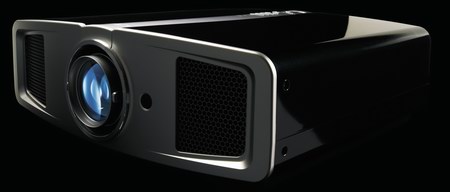
It almost seems as if JVC succeeded in making the "perfect projector", given the present technological possibilities. And after our first impression this is almost true. If one would ask us what we ourselves would wish for with this machine, we can (at present!) only think of an electrical zoom & focus (manually adjustable with the HD1), as well as more inputs. Apart from that, there is nothing to wish for.
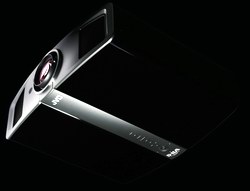
We therefore can only remain with high hopes that what was showed in this demonstration will also hold true for the machines that will be sold in the future. The JVC DLA-HD1 will appear on the German market in February, so we only have to wait a few weeks. At the time of release we will publish one of our usually elaborate reviews, which will clarify all further questions. It seems this time Christmas will be in February for many home cinema fans!
Thursday, December 14th, Ekkehart Schmitt
Translation: D. Walterfang, December 19th, 2006
7. Technical data (manufacturer data!)
Display device |
Full HD D-ILA device |
Panel size |
0.7 inch x 3 (16:9) |
Resolution |
1,920 x 1,080 pixels |
Lens |
X2 manual zoom/focus lens f=21.3-42.6mm F=3.2-4.3 |
Projection size |
60 inch – 200 inch |
Lens shift function |
80% vertical and 34% horizontal |
Light source lamp |
200-watt ultra high pressure mercury lamp |
Light output |
700 lm |
Contrast ratio |
15,000:1 |
Video Input Terminals |
HDMI x 2 |
Component x 1 (3RCA) can also be used as a RGB terminal. |
|
S Video terminal (mini DIN4 pin) x 1 |
|
Composite x 1 (1RCA terminal) |
|
Control Terminals |
RS-232 (D-sub9 pin) |
Video Input Signals |
480i/p, 576i/p, 720p60/50, 1080i60/50, 1080p60/50/24, NTSC/NTSC4.43/PAL/PAL-M/PAL-N/SECAM |
Noise level |
25dB (in normal mode) |
Power Consumption |
280-watt (2.7-watt while in stand-by) |
Dimensions (W x H x D) |
455 x 172 x 418mm (without extrusions) |
Mass |
11.6kg |
Provided accessories |
Power source cable x 1, self-lightening remote-control x 1, AAA size batteries, and lens cap |